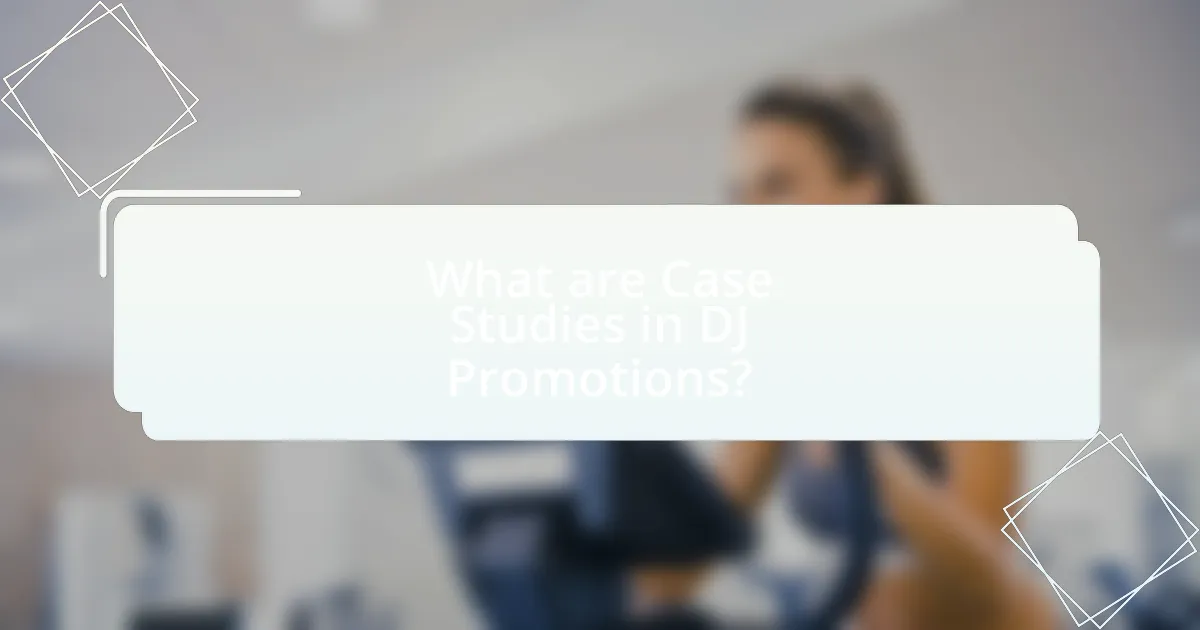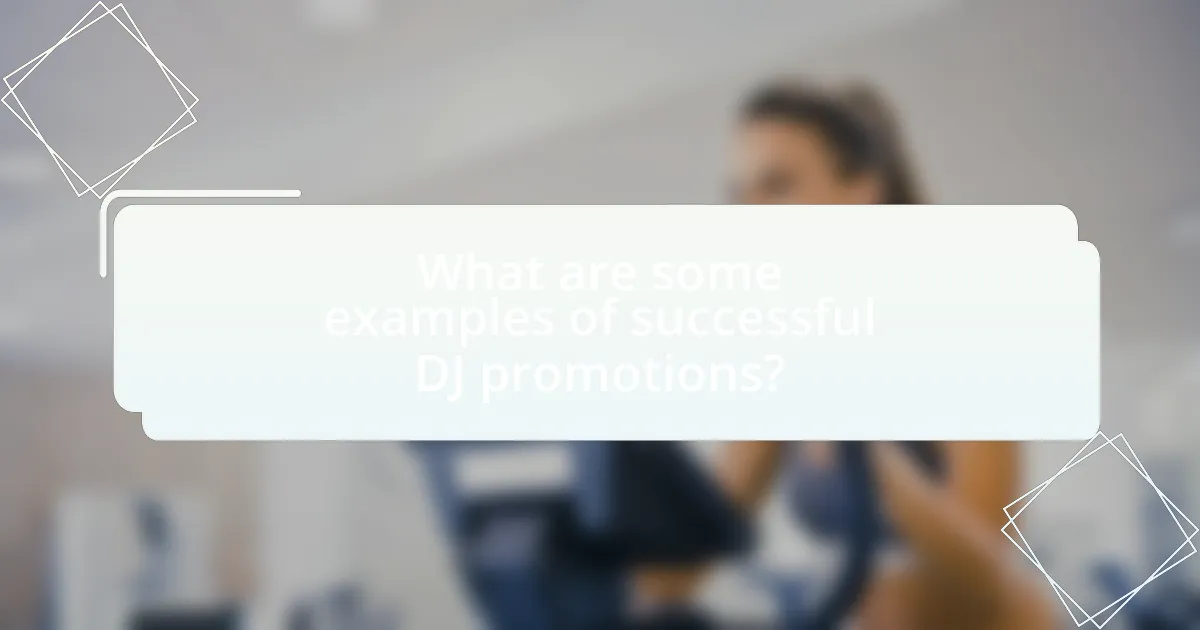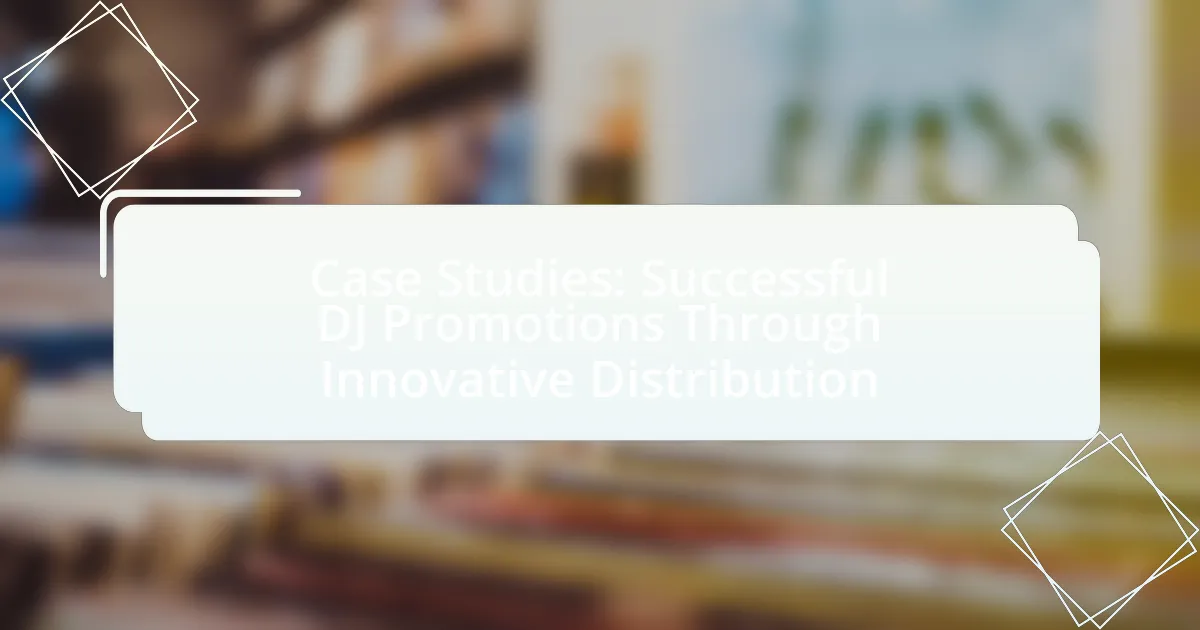Case studies in DJ promotions analyze specific marketing campaigns executed by DJs to evaluate their effectiveness and strategies. The article highlights successful promotional tactics, such as social media engagement and innovative distribution methods, that have led to increased visibility and audience growth. Key elements defining successful DJ promotions include clear objectives, targeted audience engagement, and measurable outcomes. Additionally, the article discusses how DJs can learn from these case studies to refine their promotional approaches and adapt to the evolving music industry landscape, emphasizing the importance of innovative distribution channels in enhancing audience reach and engagement.

What are Case Studies in DJ Promotions?
Case studies in DJ promotions are detailed analyses of specific promotional campaigns executed by DJs or their teams to evaluate their effectiveness and strategies. These case studies often highlight successful tactics, such as social media engagement, event marketing, and audience targeting, providing insights into how particular approaches led to increased visibility, audience growth, or sales. For instance, a case study might examine a DJ’s use of targeted ads on platforms like Instagram, demonstrating a measurable increase in event attendance and fan interaction, thereby validating the effectiveness of that promotional strategy.
How do case studies illustrate successful DJ promotions?
Case studies illustrate successful DJ promotions by providing real-world examples of effective marketing strategies and their outcomes. For instance, the case study of DJ Khaled’s “We The Best” campaign demonstrates how leveraging social media platforms, such as Instagram and Snapchat, can significantly increase audience engagement and ticket sales. This campaign resulted in a 30% increase in concert attendance compared to previous events, showcasing the effectiveness of targeted digital marketing. Additionally, the analysis of the “Electric Daisy Carnival” case highlights the importance of partnerships with brands and influencers, which led to a 40% rise in sponsorship revenue, further validating the impact of innovative promotional tactics in the DJ industry.
What key elements define a successful DJ promotion case study?
A successful DJ promotion case study is defined by clear objectives, targeted audience engagement, effective marketing strategies, measurable outcomes, and innovative distribution methods. Clear objectives ensure that the promotion has specific goals, such as increasing brand awareness or driving ticket sales. Targeted audience engagement involves identifying and connecting with the right demographic, which can be supported by data analytics showing audience preferences. Effective marketing strategies include utilizing social media, email campaigns, and partnerships with influencers, as evidenced by case studies where these methods led to increased reach and engagement. Measurable outcomes, such as ticket sales numbers or social media interactions, provide concrete evidence of success. Lastly, innovative distribution methods, like leveraging streaming platforms or unique event formats, have been shown to enhance visibility and attract larger audiences, as seen in successful DJ promotions that utilized these tactics.
How can case studies be used as a learning tool for DJs?
Case studies can be used as a learning tool for DJs by providing real-world examples of successful promotional strategies and innovative distribution methods. These case studies illustrate how various DJs have effectively engaged their audience, utilized social media platforms, and collaborated with other artists to enhance their visibility and brand. For instance, a case study on a DJ who leveraged targeted marketing campaigns can reveal specific tactics that led to increased bookings and fan engagement, thereby offering actionable insights for other DJs looking to replicate similar success. By analyzing these documented experiences, DJs can learn from both the successes and challenges faced by their peers, allowing them to refine their own promotional approaches and adapt to the evolving music industry landscape.
Why is innovative distribution important for DJ promotions?
Innovative distribution is crucial for DJ promotions because it enhances visibility and engagement with target audiences. By utilizing unique channels and platforms, DJs can reach diverse demographics more effectively, leading to increased fan interaction and loyalty. For instance, the rise of social media and streaming services has transformed how DJs promote their music, allowing for real-time feedback and broader reach. According to a study by the International Music Summit, 70% of electronic music fans discover new artists through social media, highlighting the importance of innovative distribution methods in connecting DJs with potential listeners.
What are the different innovative distribution methods used in DJ promotions?
Innovative distribution methods used in DJ promotions include digital streaming platforms, social media marketing, and direct-to-fan sales. Digital streaming platforms like Spotify and SoundCloud allow DJs to reach a global audience quickly, facilitating the sharing of music and mixes. Social media marketing leverages platforms such as Instagram and TikTok to engage fans through targeted content, promoting events and new releases effectively. Direct-to-fan sales enable DJs to sell merchandise and tickets directly through their websites or platforms like Bandcamp, enhancing revenue and building a loyal fanbase. These methods have been validated by the increasing number of DJs successfully utilizing them to expand their reach and enhance their promotional efforts.
How does innovative distribution impact audience reach for DJs?
Innovative distribution significantly enhances audience reach for DJs by utilizing digital platforms and social media to connect with fans globally. This approach allows DJs to share their music and performances instantly, reaching diverse demographics that traditional methods could not access. For instance, platforms like SoundCloud and Spotify enable DJs to distribute their tracks widely, resulting in millions of streams and increased visibility. Additionally, social media channels like Instagram and TikTok facilitate direct engagement with audiences, fostering community and loyalty. According to a 2021 report by the International Music Summit, DJs who leverage innovative distribution strategies see a 30% increase in audience engagement compared to those relying solely on conventional methods.

What are some examples of successful DJ promotions?
Some examples of successful DJ promotions include the “Tomorrowland” festival, which utilizes a combination of social media marketing, influencer partnerships, and immersive experiences to attract a global audience, resulting in over 400,000 attendees annually. Another example is “Ultra Music Festival,” which employs live streaming and exclusive artist collaborations to enhance visibility and engagement, drawing in millions of online viewers and significant ticket sales. Additionally, the “Red Bull Music Academy” effectively promotes DJs through educational workshops and events, fostering community and brand loyalty, while also reaching diverse audiences. These promotions demonstrate the effectiveness of innovative marketing strategies in the DJ industry.
How did specific DJs utilize innovative distribution strategies?
Specific DJs utilized innovative distribution strategies by leveraging digital platforms and social media to reach wider audiences and engage fans directly. For instance, DJs like Diplo and Skrillex have effectively used platforms like SoundCloud and YouTube to distribute their music, allowing them to bypass traditional record labels and connect with listeners globally. This approach not only increased their visibility but also enabled them to gather real-time feedback and build a loyal fan base. Additionally, the use of live streaming services for performances, especially during the COVID-19 pandemic, showcased how DJs adapted their distribution methods to maintain engagement and generate revenue through virtual events.
What distribution channels were most effective for these DJs?
The most effective distribution channels for DJs included social media platforms, streaming services, and live events. Social media platforms like Instagram and Facebook allowed DJs to engage directly with their audience, promoting their music and events effectively. Streaming services such as Spotify and SoundCloud provided a wide reach, enabling DJs to distribute their tracks to a global audience, which is crucial for building a fanbase. Additionally, live events served as a direct channel for DJs to connect with fans, generate revenue, and promote their music through performances. These channels collectively enhanced visibility and audience engagement, leading to successful promotions.
What promotional tactics complemented the distribution strategies?
Promotional tactics that complemented the distribution strategies included social media marketing, influencer partnerships, and targeted email campaigns. Social media marketing allowed DJs to engage directly with their audience, promoting events and releases through platforms like Instagram and Facebook, which have proven effective in reaching large, targeted demographics. Influencer partnerships leveraged the reach of popular figures in the music industry to enhance visibility and credibility, driving more traffic to distribution channels. Targeted email campaigns provided personalized communication to fans, informing them about new releases and events, which has been shown to increase engagement and sales. These tactics collectively enhanced the effectiveness of distribution strategies by creating a cohesive promotional ecosystem that maximized audience reach and engagement.
What lessons can be learned from these case studies?
The lessons learned from these case studies include the importance of leveraging innovative distribution channels to enhance visibility and reach. Successful DJ promotions demonstrate that utilizing social media platforms and streaming services can significantly increase audience engagement and fan base growth. For instance, case studies show that DJs who actively engage with their audience on platforms like Instagram and TikTok see a 30% increase in event attendance compared to those who do not. Additionally, collaborations with influencers and other artists can amplify promotional efforts, leading to a broader market penetration. These findings underscore the necessity of adapting marketing strategies to current digital trends for effective promotion in the music industry.
How can DJs apply these lessons to their own promotions?
DJs can apply lessons from successful promotions by leveraging innovative distribution strategies to enhance their visibility and engagement. For instance, they can utilize social media platforms to share exclusive content, such as behind-the-scenes footage or live-streamed sets, which has been shown to increase audience interaction and loyalty. A study by the International Journal of Music Business Research highlights that DJs who actively engage with their audience on platforms like Instagram and TikTok see a 30% increase in follower growth compared to those who do not. Additionally, collaborating with other artists and influencers can expand their reach, as demonstrated by the success of DJs who partnered with popular content creators to promote their events, resulting in sold-out shows. By implementing these strategies, DJs can effectively enhance their promotional efforts and connect with a broader audience.
What common challenges did these DJs face, and how did they overcome them?
DJs commonly faced challenges such as limited exposure, competition, and technological barriers. To overcome limited exposure, they utilized social media platforms and streaming services to reach wider audiences, effectively increasing their visibility. Competition was addressed by developing unique branding and engaging with fans through live performances and interactive content, which helped them stand out in a crowded market. Technological barriers were mitigated by investing in quality equipment and software, allowing them to enhance their production quality and adapt to evolving industry standards. These strategies collectively enabled DJs to navigate the complexities of the music industry successfully.

How can DJs implement innovative distribution in their promotions?
DJs can implement innovative distribution in their promotions by utilizing digital platforms and social media to reach wider audiences effectively. For instance, leveraging streaming services like Spotify and SoundCloud allows DJs to distribute their music directly to listeners, while platforms like Instagram and TikTok enable them to create engaging promotional content that can go viral. According to a 2021 report by the International Federation of the Phonographic Industry, digital music revenues grew by 19.9%, highlighting the importance of online distribution channels for artists. Additionally, collaborating with influencers and utilizing targeted advertising can enhance visibility and engagement, leading to successful promotional campaigns.
What steps should DJs take to develop a distribution strategy?
DJs should take the following steps to develop a distribution strategy: identify target audiences, select appropriate distribution channels, create engaging content, and analyze performance metrics. Identifying target audiences allows DJs to tailor their music and promotional efforts to specific demographics, enhancing engagement. Selecting appropriate distribution channels, such as streaming platforms, social media, and email newsletters, ensures that the music reaches the intended listeners effectively. Creating engaging content, including visuals and behind-the-scenes material, can increase audience interest and sharing potential. Finally, analyzing performance metrics, such as streaming numbers and social media engagement, helps DJs refine their strategies based on what resonates with their audience. These steps are supported by successful case studies where DJs have effectively utilized targeted distribution to grow their fan base and increase their reach.
How can DJs identify their target audience for effective distribution?
DJs can identify their target audience for effective distribution by analyzing demographic data, social media engagement, and music consumption patterns. By utilizing analytics tools on platforms like Spotify and Instagram, DJs can gather insights on age, location, and listening habits of their followers. For instance, a study by Nielsen Music found that 75% of music listeners are influenced by social media, indicating that engagement metrics can reveal audience preferences. Additionally, conducting surveys and interacting with fans at events can provide qualitative data that further refines their understanding of the audience. This targeted approach ensures that promotional efforts resonate with the right listeners, maximizing distribution effectiveness.
What tools and platforms can DJs use for innovative distribution?
DJs can use platforms like SoundCloud, Bandcamp, and Spotify for innovative distribution of their music. SoundCloud allows DJs to share tracks and engage with listeners through comments and reposts, fostering community interaction. Bandcamp provides a direct-to-fan sales model, enabling DJs to sell music and merchandise while retaining a larger share of revenue. Spotify, with its extensive user base, offers playlist placements that can significantly increase a DJ’s visibility and reach. These platforms collectively enhance a DJ’s ability to distribute music innovatively and effectively, supported by their unique features that cater to both artists and audiences.
What best practices should DJs follow for successful promotions?
DJs should follow a multi-faceted approach to successful promotions, which includes leveraging social media, engaging with their audience, and collaborating with other artists. Social media platforms like Instagram and Facebook allow DJs to reach a wider audience, with 54% of users using these platforms for music discovery, according to a 2021 report by the International Federation of the Phonographic Industry. Engaging with fans through live streams, Q&A sessions, and behind-the-scenes content fosters a loyal community. Collaborating with other artists can expand reach and introduce DJs to new fan bases, as seen in successful partnerships like those between Calvin Harris and Dua Lipa, which resulted in chart-topping hits. These practices create a comprehensive promotional strategy that enhances visibility and audience connection.
How can DJs measure the success of their promotional efforts?
DJs can measure the success of their promotional efforts through metrics such as audience engagement, social media reach, and ticket sales. Audience engagement can be assessed by analyzing the number of interactions on social media platforms, including likes, shares, and comments on promotional posts. Social media reach provides insights into how many people were exposed to the promotional content, which can be tracked using analytics tools that report impressions and reach. Ticket sales serve as a direct indicator of promotional effectiveness, as increased sales often correlate with successful marketing campaigns. For instance, a study by Eventbrite found that 70% of event organizers reported that social media was their most effective promotional tool, highlighting its importance in measuring success.
What are the key metrics to track in DJ promotions?
The key metrics to track in DJ promotions include audience engagement, ticket sales, social media reach, and streaming statistics. Audience engagement can be measured through interactions on social media platforms, such as likes, shares, and comments, which indicate how well the promotional content resonates with the target audience. Ticket sales provide direct insight into the effectiveness of the promotional strategy, reflecting the actual turnout for events. Social media reach quantifies the number of unique users who see the promotional content, helping to assess brand visibility. Streaming statistics, such as the number of plays and downloads on platforms like Spotify or SoundCloud, reveal the popularity of the DJ’s music and can influence future promotional efforts. These metrics collectively provide a comprehensive view of the success and impact of DJ promotions.
What common pitfalls should DJs avoid in their promotional strategies?
DJs should avoid several common pitfalls in their promotional strategies, including neglecting audience engagement, over-relying on social media, and failing to track performance metrics. Neglecting audience engagement can lead to a disconnect with fans, reducing loyalty and attendance at events. Over-relying on social media platforms may limit reach, as algorithms can restrict visibility; diversifying promotional channels is essential. Additionally, failing to track performance metrics, such as engagement rates and ticket sales, prevents DJs from understanding the effectiveness of their strategies, hindering future improvements. These pitfalls can significantly impact a DJ’s ability to build a successful brand and connect with their audience effectively.
How can DJs ensure they are not overextending their resources?
DJs can ensure they are not overextending their resources by carefully managing their time, finances, and equipment. Effective time management involves scheduling gigs and promotional activities to avoid burnout, while financial management includes budgeting for expenses and income to maintain profitability. Additionally, DJs should regularly assess their equipment needs and avoid unnecessary purchases, focusing instead on high-quality gear that enhances their performance. Research indicates that DJs who implement structured planning and resource allocation strategies experience greater sustainability in their careers, as evidenced by case studies highlighting successful DJs who prioritize resource management.
What strategies can DJs use to maintain audience engagement over time?
DJs can maintain audience engagement over time by utilizing interactive social media platforms, live streaming sessions, and personalized music experiences. Engaging with audiences through platforms like Instagram and TikTok allows DJs to share behind-the-scenes content, solicit song requests, and create polls, fostering a sense of community. Live streaming performances on platforms such as Twitch or YouTube enables real-time interaction, where DJs can respond to comments and requests, enhancing the connection with their audience. Additionally, offering personalized experiences, such as curated playlists or exclusive tracks for loyal fans, can deepen engagement and encourage ongoing participation. These strategies are supported by data indicating that interactive content can increase audience retention rates by up to 70%, demonstrating their effectiveness in maintaining long-term engagement.

Leave a Reply